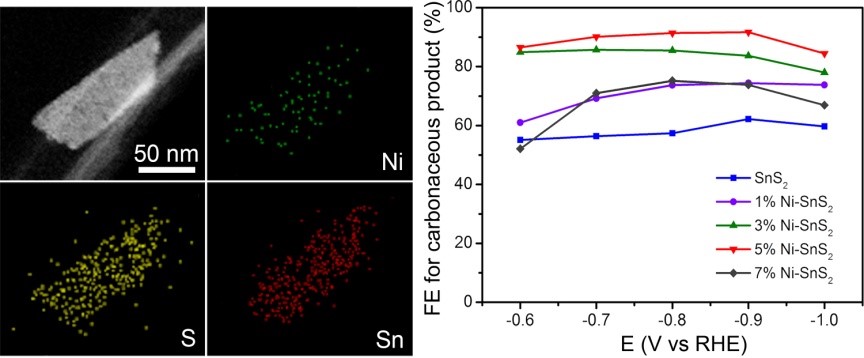- Laboratory dynamics
- notice
Laboratory dynamics
Recently, the research group of Prof. Jie Zeng has made a breakthrough in the preparation of formate and CO from electrochemical reduction of CO2 by using Ni doped SnS2 nanosheets with different doping contents as electrocatalysts. SnS2 nanosheets with appropriate Ni content were shown to possess enhanced activity and selectivity toward CO2 electrochemical reduction. This work was published on Angew. Chem. Int. Ed (Angew. Chem. Int. Ed. 2018, 57, 10954-10958) entitled as “Nickel Doping in Atomically Thin Tin Disulfide Nanosheets Enables Highly Efficient CO2 Reduction”. Graduate students An Zhang, Rong He, and Huiping Li were the co-first authors of this work.
In CO2 electroreduction, the critical
bottleneck lies in the activation of CO2 into a radical anion (CO2•-)
which requires a high reduction potential of -1.9 V vs NHE. Generally, the CO2 activation concerns an electron transfer from catalysts to a CO2 molecule, which was closely associated with the electronic structure of
catalysts. A powerful method to tailor the electronic structure of catalysts is
elemental doping, because the introduction of heteroatoms leads to the hybridization
of energy levels between dopants and pristine catalysts. Therefore, elemental doping provided a promising opportunity to facilitate
CO2 activation and thereby improve the performance of CO2 electroreduction by modifying the electronic structure of catalysts.

The mapping spectra of Ni doped SnS2 nanosheets and the electrochemical performances for CO2 reduction.
Herein, we modified atomically thin SnS2 nanosheets with Ni doping for enhanced performance towards CO2 electroreduction. The Ni doped SnS2 nanosheets exhibited higher current density and Faradaic efficiency (FE) for carbonaceous product than those of the pristine SnS2 nanosheets. When the Ni content was 5 atm %, the Ni doped SnS2 nanosheets achieved a remarkable FE of 93% for carbonaceous product with a current density of 19.6 mA cm-2 at -0.9 V vs RHE. During the potentiostatic test, the Ni doped SnS2 nanosheets remained a steady FE for carbonaceous product without obvious decay of current density. Mechanistic study revealed that Ni doping generated a defect level at conduction band edge and decreased the work function of SnS2 nanosheets, which benefited the activation of CO2 and accordingly improved the catalytic performance in CO2 electroreduction.
This work was supported by CAS, MOST of China, and National Natural Science Foundation of China.

